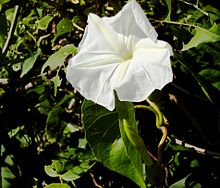| Ipomoea violacea | |
|---|---|

| |
| Scientific classification | |
| Kingdom: | Plantae |
| Clade: | Tracheophytes |
| Clade: | Angiosperms |
| Clade: | Eudicots |
| Clade: | Asterids |
| Order: | Solanales |
| Family: | Convolvulaceae |
| Genus: | Ipomoea |
| Species: | I. violacea |
| Binomial name | |
| Ipomoea violacea L. | |
Ipomoea violacea is a perennial species of Ipomoea that occurs throughout the world with the exception of the European continent. It is most commonly called beach moonflower or sea moonflower as the flowers open at night.
Description
The corolla of the flower of Ipomoea violacea is white, distinguishing this species from Ipomoea tricolor, commonly called Heavenly Blue. It is sometimes mistaken for the cultivar Pearly Gates, the corolla of which is also white, probably because of its misleading Latin binomial name, Ipomoea violacea, "violacea" meaning purple.
Comparative taxonomies
A comparison of the taxonomy of the two plants shows that they belong to different Subgenera, consequently, Ipomoea violacea should not be used as a synonym for Ipomoea tricolor. In exceptional cases where Ipomoea violacea has to be used as a synonym of Ipomoea tricolor, one must specify the incorrect usage by using the abbreviation 'Auct.' for Auctorum.
Ipomoea violacea:
- Genus: Ipomoea
- Subgenus: Eriospermum
- Section: Erpipomoea
Ipomoea tricolor:
- Genus: Ipomoea
- Subgenus: Quamoclit
- Section: Tricolor
Ergoline Alkaloids
Ipomoea violacea is no longer a synonym for Ipomoea tricolor. Ipomoea tricolor contains ergolines, along with 24 other Ipomoeas,but I. violacea is not among them.
References
- "Ipomoea violacea". Germplasm Resources Information Network. Agricultural Research Service, United States Department of Agriculture. Retrieved 18 December 2017.
- "Herbarium musei parisiensis". Archived from the original on 2016-03-03. Retrieved 2012-09-01.
- ^ "Ipomoea violacea auct". Germplasm Resources Information Network. Agricultural Research Service, United States Department of Agriculture. Retrieved 18 December 2017.
- Eich E (January 12, 2008). "4.2 Ergolines". Solanaceae and convolvulaceae - secondary metabolites: biosynthesis, chemotaxonomy, biological and economic significance: a handbook. Berlin, Heidelberg: Springer-Verlag. doi:10.1007/978-3-540-74541-9. ISBN 978-3-540-74540-2. OCLC 195613136
“Such a confusing example resulting in numerous false repetitions in studies of other authors has happened already in the first ergoline paper on Ipomoea tricolor Cav. whose seeds are known as “badoh negro”: Together with this correct synonym the species was incorrectly called I. violacea L. (Hofmann 1964) instead of I. violacea auct., non L. This is of importance since I. violacea L. is the currently accepted name of a different Ipomoea species, I. tuba (Schlecht.) G.Don (Austin and Huáman 1996).” 4.2.3 Occurrence in the Convolvulaceae (p. 224){{cite book}}: CS1 maint: postscript (link) - "Ipomoea tricolor". Germplasm Resources Information Network. Agricultural Research Service, United States Department of Agriculture. Retrieved 18 December 2017.
- Manitz, Hermann (January 1977). "Was ist Ipomoea violacea L.?". Feddes Repertorium Specierum Novarum Regni Vegetabilis (in German). 88 (4): 265–271. doi:10.1002/fedr.19770880404. ISSN 0014-8962.
- Eich E (January 12, 2008). "4.2 Ergolines". Solanaceae and convolvulaceae - secondary metabolites: biosynthesis, chemotaxonomy, biological and economic significance: a handbook. Berlin, Heidelberg: Springer-Verlag. doi:10.1007/978-3-540-74541-9. ISBN 978-3-540-74540-2. OCLC 195613136
“Such a confusing example resulting in numerous false repetitions in studies of other authors has happened already in the first ergoline paper on Ipomoea tricolor Cav. whose seeds are known as “badoh negro”: Together with this correct synonym the species was incorrectly called I. violacea L. (Hofmann 1964) instead of I. violacea auct., non L. This is of importance since I. violacea L. is the currently accepted name of a different Ipomoea species, I. tuba (Schlecht.) G.Don (Austin and Huáman 1996).” 4.2.3 Occurrence in the Convolvulaceae (p. 224){{cite book}}: CS1 maint: postscript (link) - Eich E (January 12, 2008). "4.2 Ergolines". Solanaceae and convolvulaceae - secondary metabolites: biosynthesis, chemotaxonomy, biological and economic significance: a handbook. Berlin, Heidelberg: Springer-Verlag. doi:10.1007/978-3-540-74541-9. ISBN 978-3-540-74540-2. OCLC 195613136.
Table 4.1 Unambiguously ergoline-positive Ipomoea species (pages 225-227)
Related species contain ergolines too:
Table 4.4 Unambiguously ergoline-positive Argyreia species (p. 236)
Table 4.5 Unambiguously ergoline-positive Stictocardia and Turbina species (p. 238) - Eich E (January 12, 2008). "4.2 Ergolines". Solanaceae and convolvulaceae - secondary metabolites: biosynthesis, chemotaxonomy, biological and economic significance: a handbook. Berlin, Heidelberg: Springer-Verlag. p. 235. doi:10.1007/978-3-540-74541-9. ISBN 978-3-540-74540-2. OCLC 195613136
Table 4.3 Ipomoea species apparently devoid of ergoline alkaloids (p. 235){{cite book}}: CS1 maint: postscript (link)
External links
- Dressler, S.; Schmidt, M. & Zizka, G. (2014). "Ipomoea violacea". African plants – a Photo Guide. Frankfurt/Main: Forschungsinstitut Senckenberg.
| Taxon identifiers | |
|---|---|
| Ipomoea violacea |
|